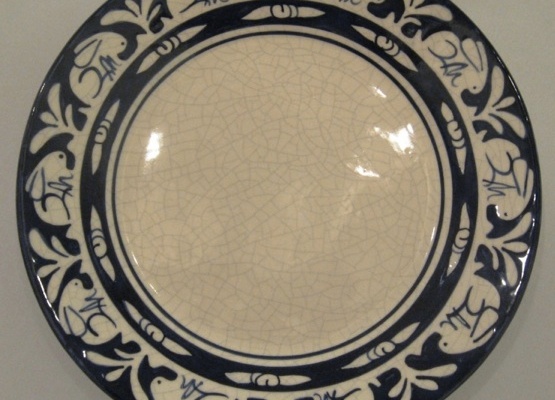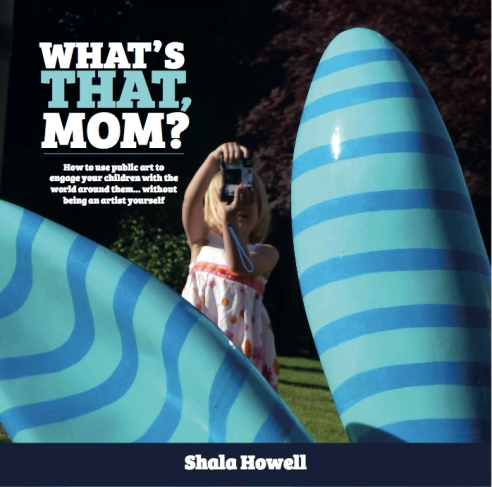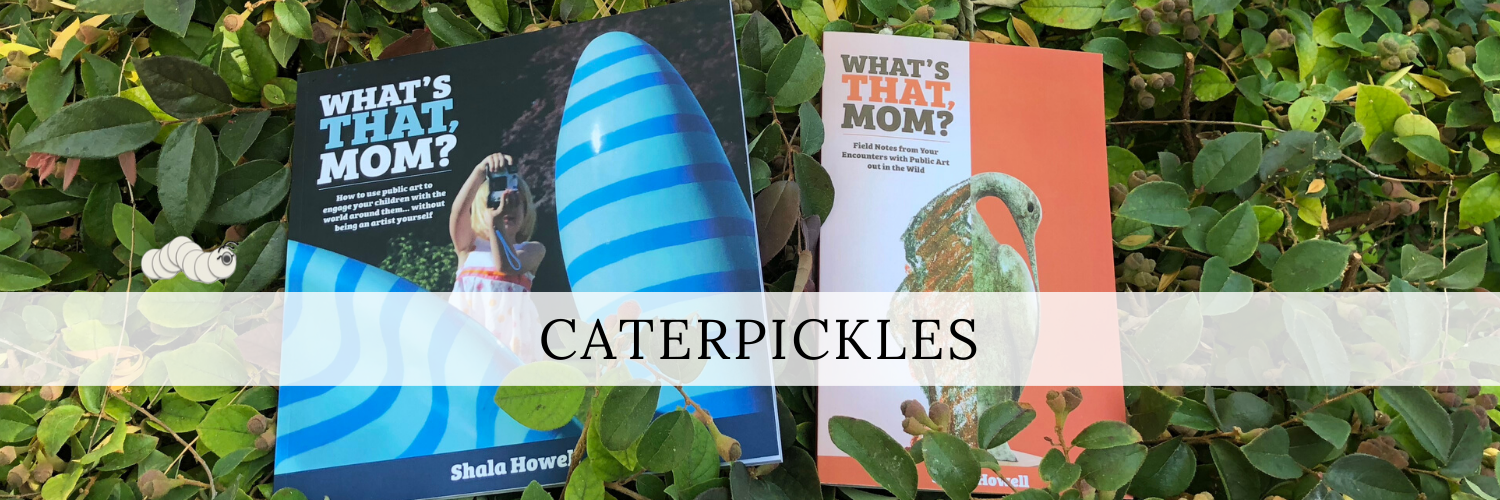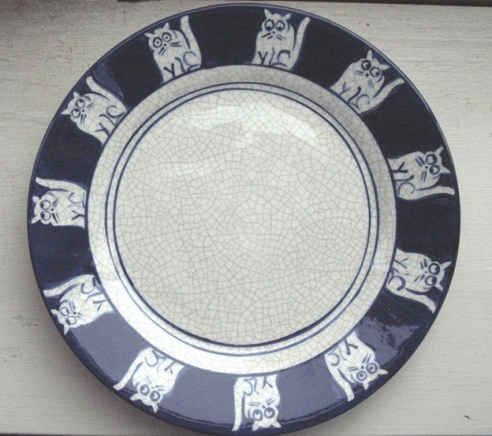“What happened to Dedham Pottery?”

Reproduction of the iconic crouching bunny dinnerware design. (Photo: Dedham Historical Society)
Weeks ago, when The Five-Year-Old began the Through the Lens series, she wanted to know why Dedham Shines had chosen to plant rabbits all around town. When I told her it was because the crouching bunny was the trademark of Dedham Pottery, an important pottery manufacturer located in Dedham, she proposed that our “very second post be a trip to the Dedham Pottery place.”
You can imagine her disappointment when I told her that Dedham Pottery closed in 1943, so we couldn’t take a tour.
The Five-Year-Old: “What happened to Dedham Pottery?”

Dedham Pottery logo. Look familiar to anyone?
Founded by the Robertson Family in 1896 at the height of America’s Arts and Craft Movement, Dedham Pottery quickly became known around the country for its high-fire stoneware with thick cobalt border designs and controlled fine crackled glaze.
Wikipedia claims that Hugh C. Robertson deliberately modeled the crackled glaze on his own pottery after the blood-red crackled glaze he saw on several pieces of Chinese pottery on display at the 1876 Centennial Exposition in Philadelphia. But according to the Dedham Pottery Guide on the Skinner Auctioneers website, Robertson stumbled on the crackled glaze accidentally while experimenting with new glazes and cooling techniques. Whatever the truth may be, the combination of the crackled glaze and the hand-painted nature designs was an instant hit with the Arts & Crafts community and still draws collectors today. According to Skinner Auctioneers, a single piece of Dedham Pottery can fetch $125-175 at auction, while sets can sell for $700-900.
Although the company’s most popular pattern was the crouching rabbit design created by Miss Alice Morse and J. Lindon Smith of the Museum of Fine Arts School in Boston, Dedham Pottery created more than 50 designs for dinnerware and serving pieces featuring elephants, dolphins, polar bears, chicks, swans, turtles, ducks, butterflies, lilies, clover, and mushrooms.
The Five-Year-Old: “Mommyo, why did you use the rabbit plate?”
Mommyo: “Because it’s the design that inspired the bunnies for the Dedham Public Art Project.”
The Five-Year-Old: “I wish they had used colors other than blue and black. Did they do any with cats?”
Mommyo: “Yes.”
The Five-Year-Old, acquisitively: “I want the whole collection! Don’t you, Mommyo?”
Can you still buy Dedham Pottery?
For those of us who like the look of Dedham Pottery, but not necessarily the price, reproductions can offer a viable alternative. You can buy your own reproduction Dedham Pottery cat, rabbit, dolphin, butterfly, mushroom, owl, quail, chicken, duck, swan, turkey, clover, polar bear, or turtle plate at the Dedham Historical Society’s online gift shop.
Although the Dedham Historical Society now owns the name Dedham Pottery and the original trademark, The Potting Shed in Concord, Massachusetts also creates and sells Dedham Pottery reproductions.
Be sure to tune in tomorrow, when The Five-Year-Old visits Ear Ye, Ear Ye – A Tail of Dedham Pottery by Elaine Matt Schaffner.
Did you know that I’ve got a book out about the 2012 Dedham Public Art Project?

My book, What’s That, Mom? provides 15 accessible, practical strategies for using public art to spark conversations with children between the ages of 3 and 10 — no artistic talent or insight required.
In addition to providing tips for viewing public art with kids ages 3-10, What’s That, Mom? offers much more detail on the 15 giant fiberglass rabbits featured in the 2012 Dedham Public Art Project, including a complete set of (higher quality) photographs, influences on their various designs, and several interviews with the local artists who painted the bunnies.
Order your copy today!
Related Links:
- Meet the Artists and their Rabbits (Dedham Shines)
- Dedham Pottery Guide (Skinner Auctioneers)
- Dedham Historical Society
- The Potting Shed (www.harelooms.com)
- Through the Lens of The Five-Year-Old: The Dedham Public Art Project (Caterpickles)



3 Responses to ““What happened to Dedham Pottery?””
shiv kripa blue pottery is famous Exporters Of Blue Pottery Mugs, Blue Pottery Tiles, Blue Pottery Mugs, Blue Pottery Pots, Manufacturers Of Blue Pottery
LikeLike
[…] The bunnies themselves were modeled after the iconic crouching rabbit made by Dedham Pottery during America’s Arts & Crafts period. When painting Ear Ye, Ear Ye – A Tail of Dedham Pottery, artist Elaine Matt Schaffner imitated the unusual crackled glaze that made Dedham Pottery so distinctive. […]
LikeLike
[…] 2012, thanks to the Dedham Public Art Project. Which explains our top two posts from that year: “What happened to Dedham Pottery?” and “Why do people throw their shoes on a […]
LikeLike